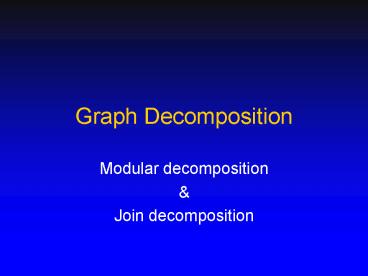Graph Decomposition - PowerPoint PPT Presentation
1 / 21
Title:
Graph Decomposition
Description:
The decomposition tree (often unique) can sometimes be used to compare two graphs ... fully connected. M. Can reduce M into a single vertex ... – PowerPoint PPT presentation
Number of Views:452
Avg rating:3.0/5.0
Title: Graph Decomposition
1
Graph Decomposition
- Modular decomposition
- Join decomposition
2
Graph decomposition
- A basic divide-and-conquer strategy
- After the decomposition, the prime graphs might
possess certain desirable properties - The decomposition tree (often unique) can
sometimes be used to compare two graphs
3
Modular decomposition
4
Modular Decomposition
- A Module is a set of vertices that are
indistinguishable from outside.
Not a module
5
Modules of a Graph
- A module M is a subset of v(G) s.t. each vertex v
in V \ M there are either no edges or all
possible edges.
M
fully connected
Can reduce M into a single vertex (The reduction
step) and separate M from the remaining subgraph
6
The Types of Modules
- Let GM be the graph induced on vertex set M
- Module M is a connected iff GM is connected.
- Module M is complement connected iff the
complement of GM is connected. - By the definition of GM, there are three types
of modules. - A Parallel module
- A series module
- A neighborhood module
7
A Parallel module
- An unconnected module is called a parallel module.
2
8
9
M
13
10
11
12
8
A series module
- A connected module whose complement is
unconnected.
2
13
10
11
12
9
A neighborhood module
- A connected module whose complement is also
connected.
5
7
4
3
6
10
Modular Decomposition
5
7
4
3
6
1
G1
2
8
1
11
2
12
13
9
13
10
11
12
11
Modular Decomposition
5
7
4
3
6
1
2
8
9
13
10
11
12
12
Modular Decomposition
5
7
4
3
6
1
2
8
9
13
10
11
12
13
Modular Decomposition
5
7
4
3
6
1
2
8
9
13
10
11
12
14
Modular Decomposition
5
7
4
3
6
1
2
8
9
13
10
11
12
15
Join decomposition
16
Join Decomposition
13
14
12
10
1
3
11
2
4
5
8
7
6
9
17
Join Decomposition
13
14
12
10
1
3
11
2
4
5
8
7
6
9
18
Join Decomposition
13
14
12
10
1
3
11
2
4
5
8
7
6
4
5
8
7
6
9
9
19
Join Decomposition
13
14
12
10
1
3
11
2
3
4
5
8
7
6
9
20
Join Decomposition
13
14
12
10
1
3
11
2
1
4
5
2
8
7
6
9
21
Join Decomposition
13
14
12
10
1
G1
3
11
2
G4
G2
Q2
Q3
4
5
G3
8
7
6
9































